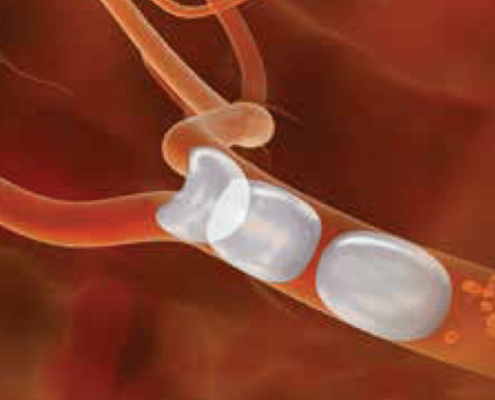Categories
Procedure
 Illustration of the HepaSphere Microspheres conforming to the architecture of the vessel lumen
Illustration of the HepaSphere Microspheres conforming to the architecture of the vessel lumen
Once through the microcatheter, HepaSphere Microspheres rebound to their initial spherical shape with a consistent cross-sectional diameter.*
Affords atraumatic conformability to the architecture of the vessel lumen, providing contact surface area with the embolic material and the vessel intima, leading to a complete occlusion of the vessel.1,2
When in contact with non-ionic contrast media or normal saline (NaCI 0.9%) before delivery, HepaSphere Microspheres expand to approximately 4x their dry state diameter.* HepaSphere Microspheres are calibrated, spherical, hydrophilic microspheres made from 2 monomers (vinyl acetate and methyl acrylate) that combine to form a copolymer (sodium acrylate alcohol copolymer). This proprietary design allows a complete occlusion of the blood vessels.
HepaSphere Microspheres’ unique properties offer the following advantages:
Doxorubicin HCl used with HepaSphere Microspheres should be reconstituted with saline, never use pure water.
REFERENCES
1. De Luis et al. 2007. “In Vivo Evaluation of a New Embolic Spherical Particle (HepaSphere) in a Kidney Animal Model.” Cardiovasc Intervent Radiol 31, no. 2 (Mar–Apr): 367–76. doi: 10.1007/s00270-007-9240-1.
2. Bilbao et al. 2008. “Comparative Study of Four Different Spherical Embolic Particles in an Animal Model: A Morphologic and Histologic Evaluation. J Vasc Interv Radiol 19, no. 11 (Nov): 1625–38. doi: 10.1016/j.jvir.2008.07.014.
3. Gupta et al. 2011. “Hepatic Arterial Embolization with Doxorubicin-Loaded Superabsorbent Polymer Microspheres in a Rabbit Liver Tumor Model.” Cardiovasc Intervent Radiol 34, no. 5 (Oct): 1021–30. doi: 10.1007/s00270- 011-0154-6.
* Data on file.

409055001_001 ID 051425